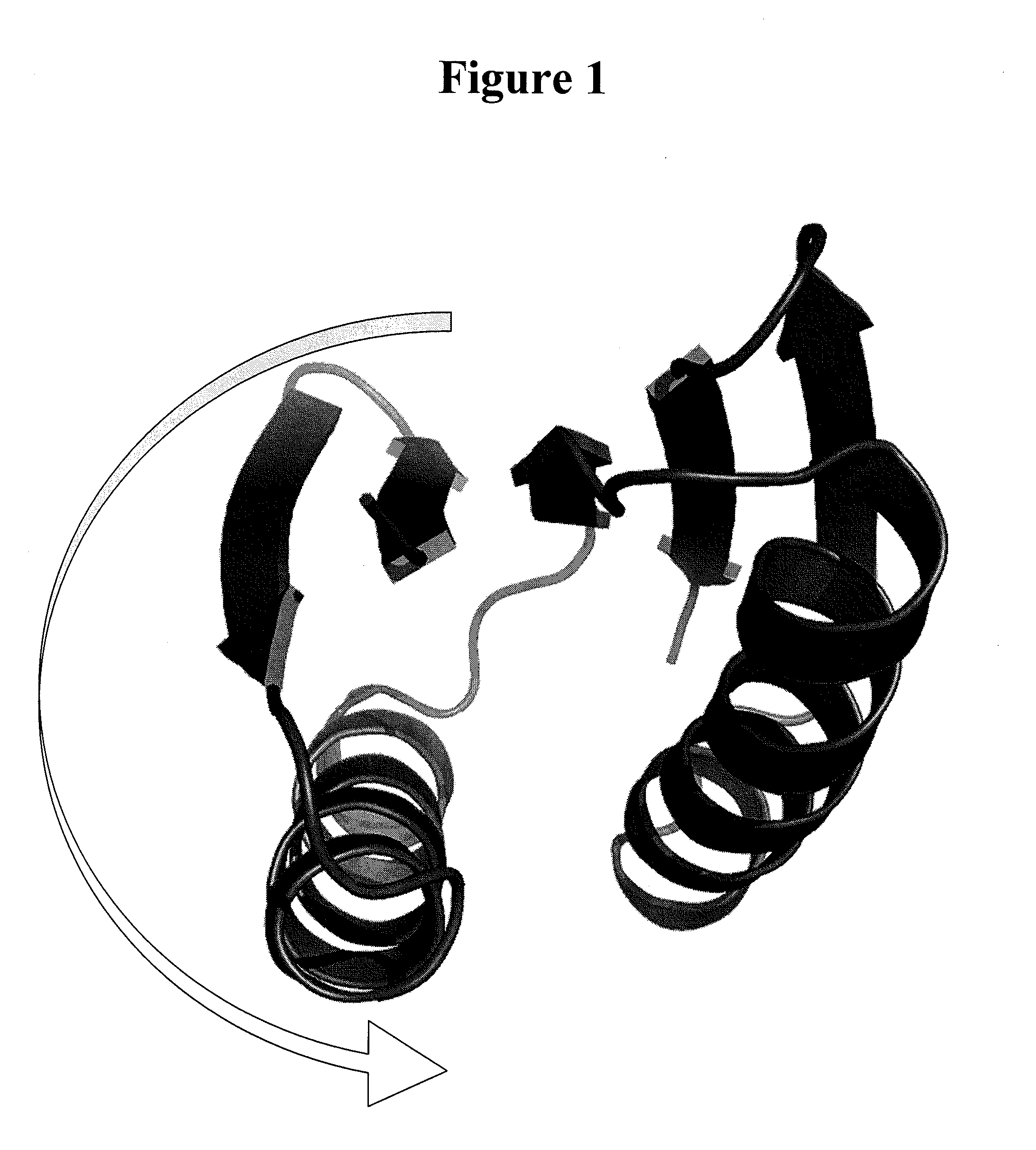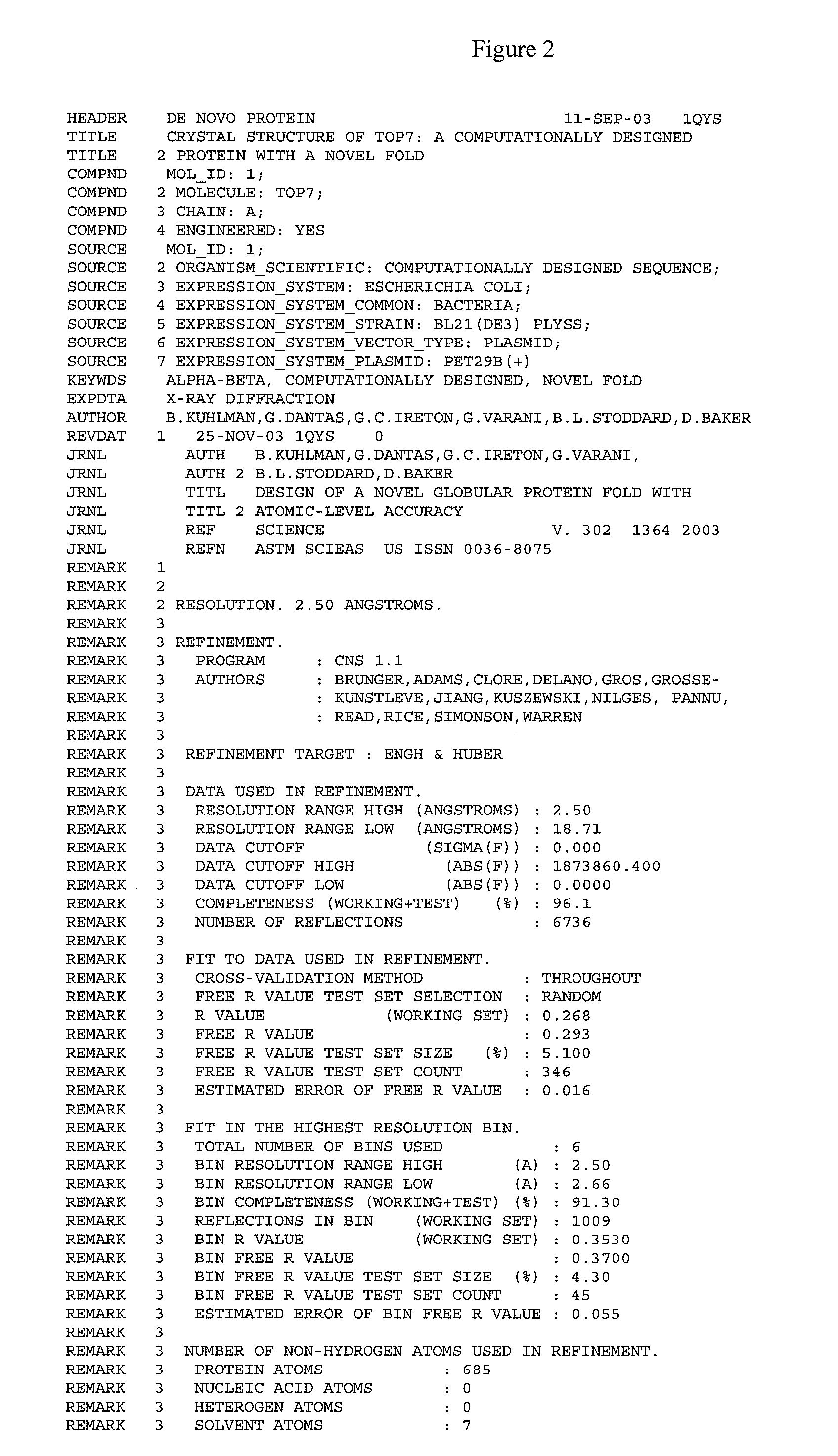Artificial Protein Scaffolds
a technology of artificial protein and scaffold, which is applied in the field of artificial protein scaffold, can solve the problems of high cost, high cost, and time-consuming of antibodies, and achieve the effect of high stability and efficient folding
- Summary
- Abstract
- Description
- Claims
- Application Information
AI Technical Summary
Benefits of technology
Problems solved by technology
Method used
Image
Examples
example 1
Thermodynamic Properties of Scaffolds with Peptide Insertions
[0072]To confirm the suitability of RD1.3 as a scaffold containing large, random peptide loops, loops 12, 34, and 56 were replaced with eight glycines each. These were chosen because glycine is the most disruptive of all amino acids from a backbone entropy standpoint—if the protein still folds and is stable with 8 glycines, it should fold with most other reasonably soluble random sequences. Another sequence, the 15 amino acid loop “S-peptide”, was also inserted into the RD1.3 protein, alone and in combination with glycine loops. S-peptide is part of the RNase-S enzyme that is known to bind to the truncated enzyme and complete it, thereby restoring function. This peptide as a loop insertion would provide both a binding and an enzymatic assay to demonstrate the ability of RD1.3 to display useful loops. The amino acid sequence of each of these test proteins is shown aligned to the Top7 sequence in FIG. 8.
[0073]Each protein te...
example 2
Designed Scaffolds
[0074]A variety of proteins related to Top7 were designed for use as protein scaffolds. The amino acid sequences of the proteins are depicted in the alignment shown in FIG. 9. As is evident in FIG. 9, insertions in each loops 12, 23, 34, 45, 56, and 67 were successfully designed, with or without point mutations at various positions throughout the scaffold. It is contemplated that these proteins, and other related proteins at least 50% identical, at least 60% identical, at least 70% identical, at least 80% identical, at least 90% identical, or at least 95% identical to one or more of these proteins or to the α-helices and β-strands of one or more of these proteins, are useful as scaffolds and as the basis for protein libraries incorporating one or more heterologous sequences as described in this application.
example 3
Design and Synthesis of Exemplary Library RD1Lib1
[0075]To construct a library of genes with variable peptide loops, the following techniques were employed. First, a set of amino acids and frequency distributions were chosen, as indicated in the Table below.
Amino AcidPercentageTyr25Ser17Leu10Ala10Asn10Gly5Ile5Asp5Arg5Pro5Trp3
[0076]In this particular library construction, only 11 amino acids were chosen. It will be apparent to those skilled in the art of protein engineering that a variety of amino acids and distributions can be used. It is often useful to avoid the use of cysteine, because this amino acid may lead to the formation of undesired disulfide bonds, and selenocysteine, because this amino acid is encoded by a UGA codon that may also be interpreted as a stop codon.
[0077]The oligonucleotides listed below were obtained from a commercial supplier (TriLink BioTechnologies (San Diego, Calif.)).
SEQ. E1: L1(SEQ ID NO: 1)GCT CCT GAT GTA CAG GTA ACC CGT (XXX)8 GAC XXX TACTAT GCA TAC A...
PUM
| Property | Measurement | Unit |
|---|---|---|
| Fraction | aaaaa | aaaaa |
| Molar density | aaaaa | aaaaa |
| Immunogenicity | aaaaa | aaaaa |
Abstract
Description
Claims
Application Information
 Login to View More
Login to View More - R&D
- Intellectual Property
- Life Sciences
- Materials
- Tech Scout
- Unparalleled Data Quality
- Higher Quality Content
- 60% Fewer Hallucinations
Browse by: Latest US Patents, China's latest patents, Technical Efficacy Thesaurus, Application Domain, Technology Topic, Popular Technical Reports.
© 2025 PatSnap. All rights reserved.Legal|Privacy policy|Modern Slavery Act Transparency Statement|Sitemap|About US| Contact US: help@patsnap.com



